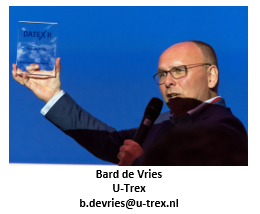- Activity 0: Project Management
Activity description
In order to continue standardisation activities based on operational user needs, and support DATEX II users in applying the standard(s) within their services, Activity 0 focuses on resource allocation, organising strategic (SG) and technical (TMG) meetings and performing risk management actions when needed. Executive decisions such as reviewing the tactical and strategic vision of DATEX II, preparing and processing meeting decisions, adopting the technical work plans, and establishing and carrying out a communication strategy, are also part of this activity. All parties involved in this activity also have a role to play in starting and maintaining liaisons with stakeholders for the further development of DATEX II.
Highlights
• DATEX II and C-Roads MoU• DATEX II and EU EIP collaboration note• STAB meeting 2018: DATEX II in the ITS Value Chain• DATEX II at ITS European Congress 2019 • Joint DATEX II and TN-ITS workshop: Aligning Standards
Activity partners
All partners of the DATEX II consortium are part of Activity 0: Project Management:
• Rijkswaterstaat, the Netherlands
• BASt, Germany
• Cerema, France
• Autostrade Tech S.p.A. (ATECH), Italy
• Trafikverket, Sweden
• Dirección General de Tráfico (DGT), Spain
• Bundesministerium für Verkehr, Innovation und Technologie (bmvit), Austria
• Intelligent Transport Systems Belgium (ITS.be), Belgium
• UK Department for Transport (DfT), United Kingdom
• Norwegian Public Roads Administration, Norway
• Instituto da mobilidade e dos transportes, I.P. (IMT, IP), Portugal
• Electronic Solutions S.R.L. (ELSOL), Romania
• Egnatia Odos AE (Egnatia), Greece
Activity lead

- Activity 1: User Support
Activity description
This activity aims at supporting the operational implementation of the delegated regulations in the Member States. Since the scope of DATEX II is very wide, this activity has been divided into sub-tasks in order to support all types of implementations. This includes the creation of user guides and support tools, maintaining the DATEX II Academy, and organizing the bi-annual DATEX II User forum. This activity also involves information provision to the user community by managing user published content, the online forum to encourage discussion, the social media channels (Youtube and LinkedIn page), as well as further expanding promotional and supporting materials.
Highlights
In 2018 the new website was developed with a more intuitive and useful format for users. This new update brought with it the update of the documentation portal. In addition, the YouTube and LinkedIn channels were launched to bring us closer to the community.
Activity partners
• NDW, The Netherlands
• Trafikverket, Sweden
• Egnatia Odos AE (Egnatia), Greece
• Cerema, France
• Autostrade Tech, Italy
• Highways England, United Kingdom
• Electronic Solutions S.R.L. (ELSOL), Romania
• Rijkswaterstaat, the Netherlands
• DGT, Spain
• HAC, Croatia
• Bundesministerium für Verkehr, Innovation und Technologie (bmvit), Austria
• ITS-Belgium, Belgium
• Department for Transport, United Kingdom
• IMT, Portugal
• Norwegian Public Roads Administration, Norway
Activity lead

- Activity 2: Data Profiles
Activity description
- Systems implementing the same DATEX II profile are interoperable by definition, however to ensure this interoperability, data-profiles need to be established in EU wide Recommended Reference Profiles (RRPs). The actual production of the profiles and the related documentation takes place within this Activity. These profiles are taken up by EU EIP in the current work towards a Reference Handbook for ITS Deployment in Europe. With the on-going maintenance of DATEX II, this Activity ensures that profiles and their documentation are available when new versions of the relevant parts are published.
Highlights
An important deliverable was issued in 2019: The DATEX II Recommended Reference Profile for SRTI messages. Based on the joint TISA-DATEX II-Amsterdam Group list of events detailing the 8 data categories from Delegated Regulation 886/2013, a RRP has been created and published as an option in the DATEX II web tool for creating exchange schemas. This first profile is the basis for the creation of profiles for all data categories mentioned in the Delegated Regulations A, B and E.
The tool can be found at: https://webtool.datex2.eu/wizard/
In the coming year, the RRPs for the delegated regulations on RTTI, MMTIS and truck parking will also be published. In addition, the Reference Handbook for ITS Deployment in Europe that will be published next year by EU EIP will contain DATEX II RRPs for all ITS service deployment guidelines.
Activity partners
• Rijkswaterstaat, the Netherlands
• BASt, Germany
• Cerema, France
• Trafikverket, Sweden
• Bundesministerium für Verkehr, Innovation und Technologie (bmvit), Austria
• UK Department for Transport (DfT), United Kingdom
• Norwegian Public Roads Administration, Norway
• Electronic Solutions S.R.L. (ELSOL), Romania
• Egnatia Odos AE (Egnatia), Greece
Activity lead

- Activity 3: Enhanced location referencing
Activity description
The location referencing approach of the DATEX II standard has been to try to integrate the existing standards into the DATEX II model so that it provides the main location referencing systems available today in DATEX II. For accurate location referencing the solution must include a high level of detail, as well as be flexible enough to be able to adapt to possible changes to the road infrastructure.
In addition to adding the Open LR extension in version 3, DATEX II has tried to integrate the existing standards into the DATEX II model, including ALERT-C, TPEG-Loc and EN ISO 19148, which presently make up the main location referencing systems available in DATEX II. Due to new 3D mapping technologies and equipment, the location reference of a moving event could affect the “static view”. The combination of the existing form of infrastructure managers and road operators with the arrival of a dynamic and precise location of moving event is therefore of added value to DATEX II.
Highlights
• Location referencing package
• Harmonisation with INSPIRE
Activity partners
• Cerema, France
• Rijkswaterstaat, the Netherlands
• National Data Warehouse for traffic information, the Netherlands
• Austriatech, Austria
• AFINAG, Austria
• Autostrade per l´Italia, Italy
• Egnatia Odos AE (Egnatia), Greece
• Electronic Solutions S.R.L. (ELSOL), Romania
• STA with VIATI, Sweden
• Norwegian Public Roads Administration, Norway
• Highways England, United Kingdom
Activity lead

- Activity 4: Integrate the urban dimension of ITS (METR)
Activity description
This activity will provide DATEX data models to support the publication of electronic traffic bans and traffic regulations. It is intended to support the exchange of informational content from road traffic authorities issuing traffic regulation orders and organisations implementing these orders to other organisations providing ITS services or onward information exchange.
One major field of traffic related data not yet properly covered by the DATEX II model is traffic regulations. When the DATEX II Situation model had been created initially in the early millennium years, the focus of DATEX II had very much been on traffic management. Traffic regulations were hence covered mainly from the perspective of road operators. The parts of the model that cover them mix this aspect with pure traffic management activities like providing recommendations or information. On the other hand, it has meanwhile become clear that current ITS service – like navigation – suffer from the aspect of missing clear information about traffic restrictions due to traffic regulation. Future infrastructure support for automated driving will mandatorily require detailed traffic regulation information. This Activity has therefore been started to refactor traffic regulation in separate DATEX II v3.0 packages that can cover today’s requirements – e.g. regarding restricted zones in urban environment – and are prepared for future automated driving support.
Highlights
Activity 4 has successfully agreed during 2019 on the use cases and design decisions required for the development of a DATEX II v3.0 data model for METR. This model has been drafted now and has been issued for a Committee Internal Ballot in CEN/TC 278 Working Group 8 as a first step on its way to be standardised as CEN/TS 16157 Part 11.
Activity partners
• AlbrechtConsult on behalf of BASt, Germany
• AustriaTech, Austria
• ITS Belgium, Belgium
• Cerema, France
• Autostrade Tech, Italy
• Rijkswaterstaat, the Netherlands
• ARMIS, Portugal
• STA, Sweden
• Highways England, United Kingdom
• Norwegian Public Roads Administration, Norway
• Electronic Solutions S.R.L. (ELSOL), Romania
• Egnatia Odos AE (Egnatia), Greece
• DGT, Spain
Activity lead

- Activity 5: Exchange and Collaborating ITS Services
Activity description
Activity 5 handles the standardising of the method through which the content is delivered from one Centre to another. Precisely defining the exchange mechanism is crucial to improving the reliability and effective timing of Exchange to implement operational functionalities. This ensures reciprocal awareness of Processing and Information status among the centres.
DATEX Exchange Specifications have been designed to support two main business cases: Information Delivery and Collaborative ITS Services, the latter being the bidirectional data exchange needed to enable workflows to negotiate and agree on proposed ITS Service to be activated. Based on the level of maturity of the specifications, appropriately formatted specification and draft documentation is sent as an input to standardisation bodies as ISO and CEN to become an officially approved Technical Specification or Standard. Further tasks within Activity 5 include linking support to the Standardisation of Traffic Management Plans, the activities of which have been taken into account in document CEN TC278/WG17, which is publishing the TS 16157-8 Traffic Management Plan.
Highlights
• The Exchange 2018 PIM has been submitted to ISO and CEN for revision. A CEN/ISO TS 19468 based on that model has been approved at a CEN/ISO level and was published in October 2018.
• The Platform Specific Model and Exchange 2018 PSM Specification have been defined to implement the PIM as SOAP WebService. In order for the implementation to also be approved as an ISO/CEN Technical Specification, a TS draft is underway in ISO/CEN as TS 14827-4.
• A Collaboration ITS Services (CIS) specification is also being drafted and is to be added in a second phase of revision of PIM and PSM (i.e. included later in TS 19468 / TS 14827-4).
Activity partners
• Rijkswaterstaat, The Netherlands
• BASt, Germany
• Cerema, France
• Autostrade Tech S.p.A. (ATECH), Italy
• Trafikverket, Sweden
• UK Department for Transport (DfT), United Kingdom
• Instituto da mobilidade e dos transportes, I.P. (IMT, IP), Portugal
Activity lead

- Activity 6: Enhanced Usability
Activity description
As the DATEX II model grows in complexity both in depth and number of functional parts, maintaining its accessibility and applicability for users is of increasing importance. This is the task of Activity 6. For example, due to the widening DATEX II domain, new “Use Case” domains beyond TMS are collected, along with the information subsets to assemble a profiled version of DATEX II as needed. Also, in response to the strong demand by road operators to open up their data to app developers in order to achieve maximum usability in the Open Data domain, the applicability of DATEX II in the open data domain can be improved by supporting standards that are used in the app development world.
Activity highlights
• D2Light app• JSON schema support
In the coming year, this activity will define its support of Open Linked Data and in the DATEX schema generation tools add support for ASN.1 mapping.
Activity partners
• Rijkswaterstaat, the Netherlands
• BASt, Germany
• Cerema, France
• Autostrade Tech S.p.A. (ATECH), Italy
• Trafikverket, Sweden
• Bundesministerium für Verkehr, Innovation und Technologie (bmvit), Austria
• UK Department for Transport (DfT), United Kingdom
• Norwegian Public Roads Administration, Norway
• Instituto da mobilidade e dos transportes, I.P. (IMT, IP), Portugal
• Electronic Solutions S.R.L. (ELSOL), Romania
• Egnatia Odos AE (Egnatia), Greece
Activity lead

- Activity 7: C-ITS Harmonisation
Activity description
Activity 7 of the DATEX II Programme Support Action (PSA) - ‘C-ITS Harmonisation’ - focuses on the developments in the domain of Cooperative-ITS (C-ITS) and especially its effect on information provision to and from road operators transferring data via DATEX II. Where information elements are used in both domains, DATEX II and C-ITS, or targeting the same domain concepts, it is crucial that definitions are harmonised.
The activity will come up with an analysis and inventory of European DATEXII-C-ITS implementations. Members of activity 7 will investigate upcoming C-ITS Day 1.5 applications and derive use-cases, where DATEX II might be needed to feed data into C-ITS services as well as for publishing DATEX II information that is received from a C-ITS system.
Since the DATEX II community also needs constant liaison with the C-ITS community, this activity also works to foster liaison between relevant and potential new partners in the world of C-ITS.
Activity highlights
The signing of a collaboration Note of DATEX II and C-Roads at the European ITS Congress in Eindhoven in June 2019 paved the ground for a data collection and analysis activity with the objective to identify modification requirements of DATEX II specifications with regard to the support of Day 1 C-ITS roll-out.
Activity partners
• Austriatech, Austria
• ASFINAG, Austria
• Rijkswaterstaat, the Netherlands
• National Data Warehouse for traffic information, the Netherlands
• Cerema, France
• AlbrechtConsult, Germany
• BASt, Germany
• Highways England, United Kingdom
• Autostrade per l´Italia, Italy
• Egnatia Odos AE (Egnatia), Greece
• Electronic Solutions S.R.L. (ELSOL), Romania
• Norwegian Public Roads Administration, Norway
Activity lead

- Activity 8 - Maintenance and input to standardisation
Activity description
While other activities produce content for new items, the subsequent maintenance of those items is addressed in this Activity. Since DATEX II is a living standard, problems and small user requests are bound to arise. These are considered and addressed within this activity. All parts of the DATEX II standards, supportive tooling, documentation and user guidance that need continuous maintenance are called “DATEX II configuration items”.
Along with liaising with other standardisation organisations relevant to the DATEXII content specification, this activity is central to the DATEX II support action (Activity 1) because it established the European Standards and the modular version 3 with its many improvements in usability. Users of these specifications can be confident that the models have passed through an intense consensus-building process and have potential for deployment on a large scale.
Activity highlights
Four parts of the DATEX II specifications have for the first time become full European Standards:
• EN 16157-1:2018 modelling methodology
• EN 16157-2:2019 location referencing model
• EN 16157-3:2018 situation model
• EN 16157-7:2018 common structuresIn the coming year, this activity will produce a release 3.1 with VMS, road traffic data, traffic management plans, enhanced rerouting, urban extensions, and traffic signal timing information, and will progress CEN Technical Specifications for Parts 6 (Parking) and 10 (Vehicle Energy Infrastructure).
Activity partners
• Highways England, United Kingdom
• ITS Belgium, Belgium
• Cerema, France
• BASt, Germany
• Autostrade Tech, Italy
• Rijkswaterstaat, the Netherlands
• Instituto da mobilidade e dos transportes, I.P. (IMT, IP), Portugal
• DGT, Spain
• Trafikverket, Sweden
• Egnatia Odos AE (Egnatia), Greece
• AustriaTech, Austria
• Electronic Solutions S.R.L. (ELSOL), Romania
• Statens vegvesen, Norway
Activity lead
